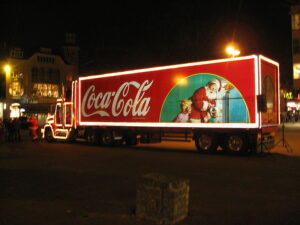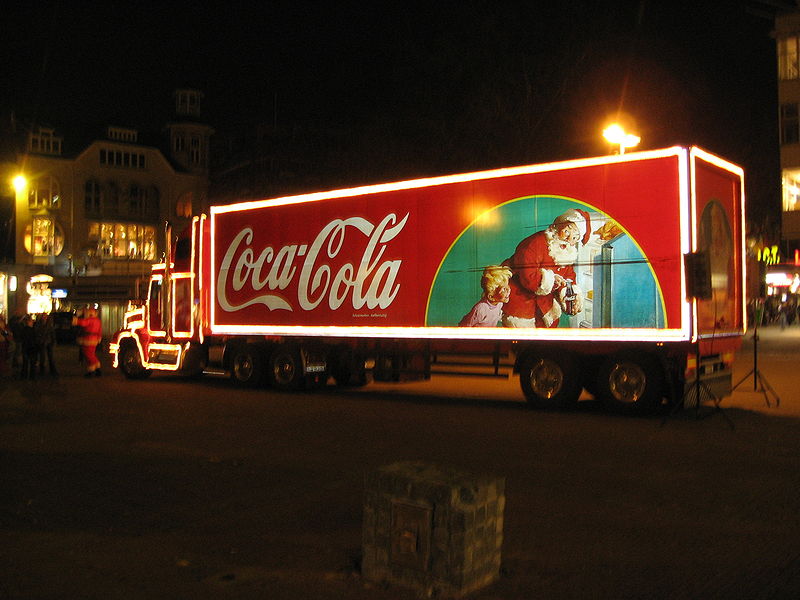
Photo courtesy of Wikimedia Commons
Consumerism. Whether you feel its effects or not, it is an undeniable fact that overconsumption is an invisible force that drives our holiday gift-giving traditions today.
“Gifts Unwrapped”, an article by online blog Gifts International, outlines the history of gift-giving during the Christmas holidays.
For those who celebrate the religious side of Christmas, the origin of presents dates back to Jesus’ birth with the presentation of gifts from the Three Wise Men in the Nativity story.
While the gifts of frankincense, gold and myrrh became known as the original presents of Christmas, the images and traditions of Christmas we associate with the holidays today were born out of the American Dream.
Iconic Santa Claus Coca-Cola advertisements of the 1940s and 50s, classic Christmas songs and timeless movie classics such as “A Charlie Brown Christmas” and “It’s a Wonderful Life” relate to a time in the United States when the meaning of Christmas no longer had a solely religious stance.
The concept of the American Dream has played a big role in influencing how the American public differentiates wants from needs. With a society that promotes a lifestyle where everyone can become prosperous and successful, there stems a culture of extreme desire for the biggest and best things. This has been exacerbated by promoting consumerism as the driver for America’s economy.
The general idea of consumerism is that the more one purchases, the more comfortable they will be and the better off the economy will be. This system works for a short period of time and leads to the production of more goods, allowing for more jobs to be created and for people to want to spend more.
But all of this leads back to the increase in demand for goods, which means workers must work more hours to meet demand. This vicious cycle of capitalism breeds the toxic mentality of feeling the need to work longer, harder and more efficiently to earn the extra dollar and come one step closer to achieving the biggest and best new thing.
Consumerism has driven the voracious degradation of the environment.
Researchers have found that the problem mainly lies in transportation. With the average amount of food consumption increasing every year and more and more opportunities to shop online, the transportation of all the unnecessary goods has become hazardous to the environment.
Fundamentally, consumerism is a social disease that has smuggled its way into our consciences. It is the voice in your head telling you just need that one little thing and then you will be happy.
What exactly can we do to combat the materialist voice in our heads and become more conscientious shoppers?
The answer lies within our daily decisions.
Ava Langridge, a senior at International High School in San Francisco, is well versed in helping others become conscientious shoppers.
Langridge runs an Instagram account called The Zero Waste Teen (@the_zero_waste_teen). She has gained a following of more than 50,000 users. She uses the platform to spread awareness on climate issues as well as share tips on becoming a more environmentally conscious shopper.
“I started my Instagram account in hopes that it would help others realize zero-waste living isn’t as difficult as it seems,” she said. “The premise of the account is to focus on what you can do, instead of what you can’t.”
With technology playing such a huge factor in spinning consumerism culture, The Zero Waste Teen is a breath of fresh air amongst a world of calculated algorithms made to coerce the person behind the screen into purchasing whatever product is being advertised.
“I am still a very materialistic person, whether I want to be or not. I know how hard it is to convince anyone to completely stop consuming,” said Langridge. “But I also know that we can convince people to start consuming consciously and consume sustainable products, something that is a lot easier than most think.”
For all the shoppers out there who want to be more sustainable, here are some of Langridge’s recommendations for fun sustainable clothing and accessory brands for teenagers:
Girlfriend, Ghanda, Shop the Curate, Sunshine Series, Fleur and Butter and Neutrall.
Anton Krukowski, a science teacher at Lick-Wilmerding High School, shared his thoughts on consumerism and how it has played a role in his family’s Christmas traditions.
“Exchanging gifts is centered around making sure there’s a balance between the three of my kids and it’s strange because I don’t feel like we’re a very materialistic family,” he said.
Krukowski mentioned that his love for vintage shopping, particularly for used books and vinyl records, has transferred to his three kids. They love spending time going into thrift stores and shopping for vintage clothing.
“It’s funny how it’s still possible to make things like that feel special and like a gift,” he said.
Shopping at local businesses is a great way to reduce your carbon footprint, find a unique gift for someone and support a small business. “There used to be a very reliable gift store where my daughter worked,” Krukowski said. “We knew the owner and she had a good taste so it was easy to find small gifts, but it’s gone now.”
In the Bay Area, gentrification and rising rents cause many small businesses to fail — as does the pressure from large corporate and online stores.
LWHS Stagecraft teacher Kate Boyd discussed a challenge she set up with her friends back in 2006. The goal was to not purchase anything new for an entire year outside of general consumables and new underwear.
Boyd said the idea stemmed at a time when consumerism felt rampant and people constantly bought things they didn’t need to make themselves feel better.
“It’s what Americans do,” she said. “It’s specific to our culture, this is how we prove we’re alive. It’s sad.”
Boyd and her group resisted consumerism culture successfully for a year and supported each other throughout the process. She said it was a huge relief to not engage with the pressures from advertisements and that the process built stronger connections to items and people when she would purchase something.
“We go through our days swimming in all of these images and to be able to just turn off a portion of them was really valuable,” she said. “We had a lot of fun thrifting. I did a lot of shopping on Craigslist, where you get to meet the people you’re shopping from so I got to hear the stories behind what I was buying which felt good, it was like, ‘Okay, I’m not adding to the landfill.’”
Throughout the-year long journey, Boyd and her group of friends caught the attention of news sources big and small. A short article in the San Francisco Chronicle was written about them and they were featured on an episode of the Today Show in 2006.
However, even with the positive message the group was spreading, they still received some backlash.
“One is that we were middle-class people so we could afford to do this challenge. Whereas shopping at thrift stores for many people is not a cute thing, it’s something that they have to do,” she said. “And we would also often hear that our economy relies on consuming, which is so obviously unsustainable for multiple reasons.”
Recently, thrifting has become something that is seen as a trendy or cute way to find unique pieces for less money than one would pay at a name-brand store. However, it can be easy to start over-consuming even when one is shopping sustainably.
“Thrifting fulfills my creative desires, but it also enables me to deliver my mission,” Langridge says. “I emphasize the benefits and creativity of repurposing, and remind us that we live on a planet with exhausted resources because of overconsumption.”
While thrifting remains a great way for someone to search for gifts over the holidays, sometimes the best gifts are the ones made by others.
Both Krukowski and Boyd agree that some of the best gifts to exchange are those that are made and created by friends and family. As cliche as it sounds, the gifts that mean the most are not the ones found in a catalog or under a tree, but those made with meaning and love.







